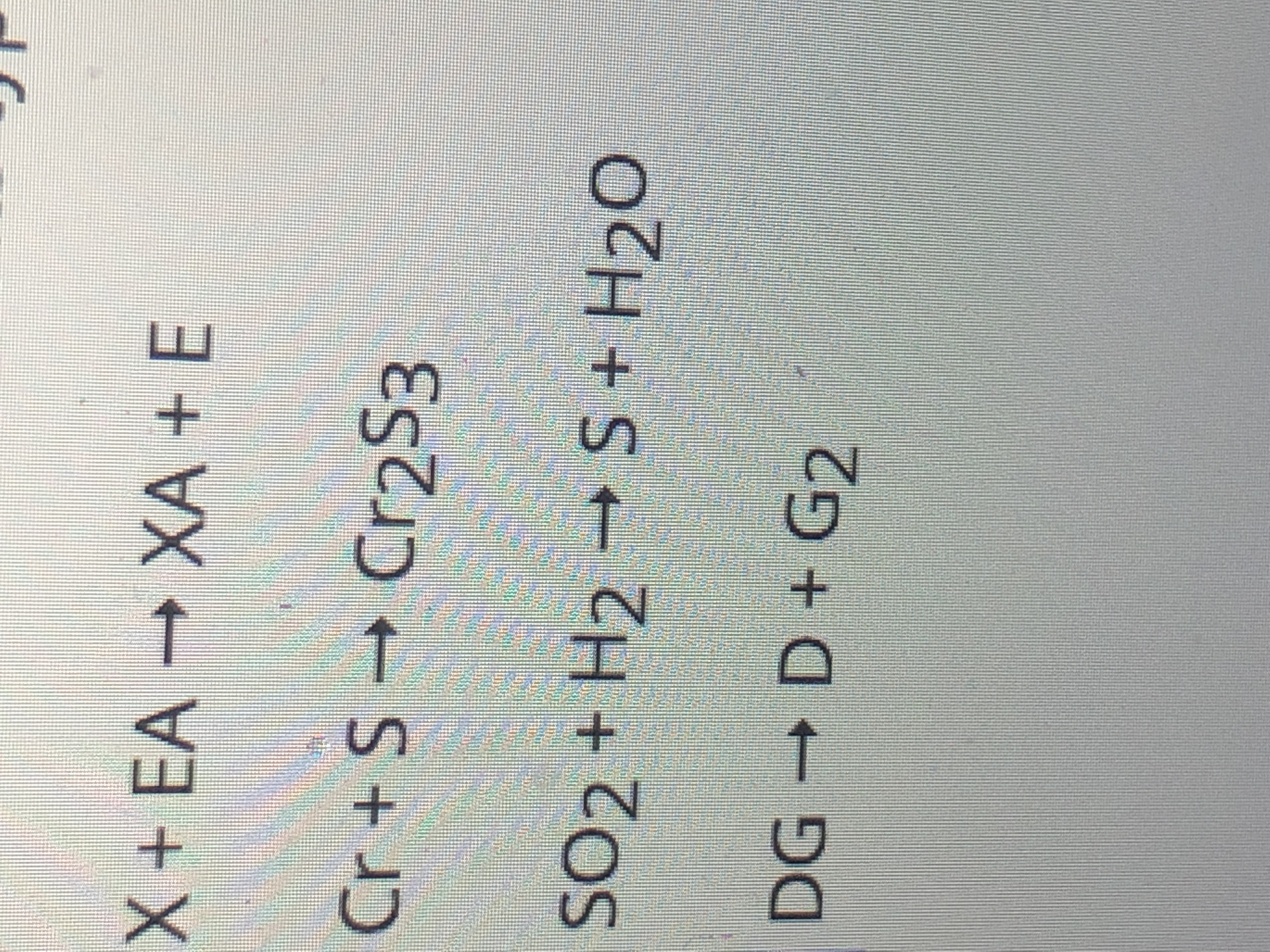
Chemistry
10th Edition
ISBN: 9781305957404
Author: Steven S. Zumdahl, Susan A. Zumdahl, Donald J. DeCoste
Publisher: Cengage Learning
expand_more
expand_more
format_list_bulleted
Concept explainers
Question
Match with correct
a. Single displacement
b. Synthesis
c. Combustion
d. Decomposition
e. Double displacement

Expert Solution
This question has been solved!
Explore an expertly crafted, step-by-step solution for a thorough understanding of key concepts.
Step by stepSolved in 2 steps with 2 images

Knowledge Booster
Learn more about
Need a deep-dive on the concept behind this application? Look no further. Learn more about this topic, chemistry and related others by exploring similar questions and additional content below.Similar questions
- Classify the following reactions: a. CH4 + 2 O2 ⟶ CO2 + 2 H2Oi. Combustionii. Double replacementiii. Single replacementiv. Synthesis/combinationv. Decomposition b. N2 + 3 Cl2 ⟶ 2 NCl3i. Combustionii. Double replacementiii. Single replacementiv. Synthesis/combinationv. Decomposition c. 2 Al + 3 CuSO4 ⟶ Al2(SO4)3 + 3 Cui. Combustionii. Double replacementiii. Single replacementiv. Synthesis/combinationv. Decompositionarrow_forwardThe two questions on the second photo are based on the table? How do I do them?arrow_forwardHelparrow_forward
- QUESTION 3 Chemical reactionc most comonly do work on their surroundings by a. having gases as reagents only O b. producing a lot of heat C. Forming neutral solutions from acids and bases d. forming gas phase productsarrow_forwardAnswer questions 2 & 3arrow_forwardMatch with correct a. Single displacement b. Synthesis c. Combustion d. Decomposition e. Double displacementarrow_forward
- Why are the changes of state (e.g., boiling) not a chemical reaction A. Changes of state create new substances B. Changes of state do not create new substance C. Changes of state are always reversible D. Changes in state cannot always be detected E. Changes of state do not involve chemicalsarrow_forward5) If all the NaHCO3 in bag 2 reacted, calculate the number of moles of gas produced? tates) E Focusarrow_forward100% Normal text Arial 11 B 1 - 1 2 3. 4 I5 6 7 8 T9 1 10 11 I 12 13 2. Copper (1) carbonate heptahydrate has the chemical formula a) CUCO3.5H20 b) CU2CO3.5H2O c) CuCoz. 7H20 d) Cu2CO3. 7H20 B. A double displacement reaction may be defined as: a) two or more simple substances producing a more complex substance *b) a more complex substance breaking down into simpler ones c) one element replacing another element in a compound d) a reaction involving two ionic compounds where the cations and anions replace each other Neutralisation occurs when: a) an acid is mixed with water b) a base is mixed with water c) a salt is mixed with an acid d) an acid is mixed with a base 山TOA Ai étv Book Proarrow_forward
- 7. 5.00 mL of stock solution is diluted to 25.00 mL, producing solution ALPHA. 10.00 mL of solution ALPHA is diluted to 25.00 mL, resulting in solution BETA. 10.00 mL of solution BETA is then diluted to 25.00 mL, producing solution GAMMA. a. Determine the dilution factor in producing solution ALPHA from the stock solution. b. Determine the dilution factor in producing solution BETA from the solution ALPHA. C. Determine the dilution factor in producing solution GAMMA from the stock solution BETA. d. Determine the overall serial dilution factor in producing solution GAMMA from the stock solution.arrow_forwardneed help with 9 and 10arrow_forward12. For each reaction below, the starting mass/volume of each reagent is provided as well as the final mass of product isolated. Calculate the theoretical and percent yield for each reaction. a. b. OH OH + l MW 122 1.50 g CI MW 141 d 1.21 g/mL 0.250 mL MW 60.1 7.40 g 1. PhMgBr MW 181 905 mg 2. HCI H3PO4 OH Ph MW 164 1.86 g Ph MW 260 547 mg + H₂Oarrow_forward
arrow_back_ios
arrow_forward_ios
Recommended textbooks for you
 ChemistryChemistryISBN:9781305957404Author:Steven S. Zumdahl, Susan A. Zumdahl, Donald J. DeCostePublisher:Cengage Learning
ChemistryChemistryISBN:9781305957404Author:Steven S. Zumdahl, Susan A. Zumdahl, Donald J. DeCostePublisher:Cengage Learning ChemistryChemistryISBN:9781259911156Author:Raymond Chang Dr., Jason Overby ProfessorPublisher:McGraw-Hill Education
ChemistryChemistryISBN:9781259911156Author:Raymond Chang Dr., Jason Overby ProfessorPublisher:McGraw-Hill Education Principles of Instrumental AnalysisChemistryISBN:9781305577213Author:Douglas A. Skoog, F. James Holler, Stanley R. CrouchPublisher:Cengage Learning
Principles of Instrumental AnalysisChemistryISBN:9781305577213Author:Douglas A. Skoog, F. James Holler, Stanley R. CrouchPublisher:Cengage Learning Organic ChemistryChemistryISBN:9780078021558Author:Janice Gorzynski Smith Dr.Publisher:McGraw-Hill Education
Organic ChemistryChemistryISBN:9780078021558Author:Janice Gorzynski Smith Dr.Publisher:McGraw-Hill Education Chemistry: Principles and ReactionsChemistryISBN:9781305079373Author:William L. Masterton, Cecile N. HurleyPublisher:Cengage Learning
Chemistry: Principles and ReactionsChemistryISBN:9781305079373Author:William L. Masterton, Cecile N. HurleyPublisher:Cengage Learning Elementary Principles of Chemical Processes, Bind...ChemistryISBN:9781118431221Author:Richard M. Felder, Ronald W. Rousseau, Lisa G. BullardPublisher:WILEY
Elementary Principles of Chemical Processes, Bind...ChemistryISBN:9781118431221Author:Richard M. Felder, Ronald W. Rousseau, Lisa G. BullardPublisher:WILEY

Chemistry
Chemistry
ISBN:9781305957404
Author:Steven S. Zumdahl, Susan A. Zumdahl, Donald J. DeCoste
Publisher:Cengage Learning

Chemistry
Chemistry
ISBN:9781259911156
Author:Raymond Chang Dr., Jason Overby Professor
Publisher:McGraw-Hill Education

Principles of Instrumental Analysis
Chemistry
ISBN:9781305577213
Author:Douglas A. Skoog, F. James Holler, Stanley R. Crouch
Publisher:Cengage Learning

Organic Chemistry
Chemistry
ISBN:9780078021558
Author:Janice Gorzynski Smith Dr.
Publisher:McGraw-Hill Education

Chemistry: Principles and Reactions
Chemistry
ISBN:9781305079373
Author:William L. Masterton, Cecile N. Hurley
Publisher:Cengage Learning

Elementary Principles of Chemical Processes, Bind...
Chemistry
ISBN:9781118431221
Author:Richard M. Felder, Ronald W. Rousseau, Lisa G. Bullard
Publisher:WILEY